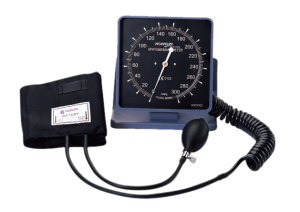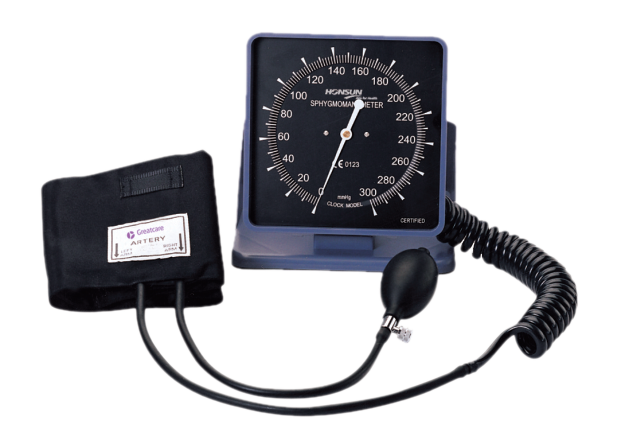Aneroid Sphygmomanometer (Desk Type) – NMDE620503
Aneroid Sphygmomanometer (Desk Type)
Description
Round square shape 14.8cm diameter dial, Front and Rear adjustable for easy of reading, cotton cuff W/ D-ring, black latex bulb, latex inflation system, non-stop-pin, with latex tube.
Aneroid Desk Type Sphygmomanometer of a dial which ordinarily ascends to 300mmHg and a meager metal layered roars inside. There is a shaft which interfaces two pins at right points to one another; one of these lays on the cries, the other is inside a curved sided triangle which networks with a pinion associated with the dial pointer.
A slim wound spring (known as a hair spring) is likewise associated with the pinion and returns the pointer to zero when the strain is delivered.
When being used the measure is associated with a pulse sleeve around the patient's arm. As the strain in the sleeve rises, the pin laying on the extending cries is lifted. This development is communicated by the other pin which moves the triangle and consequently the pinion and pointer. This should be visible in figure 2.
Aneroid Desk Type Sphygmomanometer
The accompanying blunders might happen:
Spills in the framework.
Assuming a break creates in the framework fold the sleeve over itself and secure the end. Blow up the framework to 250mmHg, watch the pointer. Assuming it gradually drops there is a hole - it is probably going to be in the sleeve or expansion bulb. It is genuinely uncommon for a break to happen in the actual check. A little pointed brush with sudsy water on it will assist with tracking down the littlest break.

Erroneous zero - the measure doesn't get back to zero after the sleeve has been collapsed. On certain models, for example, the model captured, there is a change screw to set the zero point. Anyway utilizing this screw requires the instrument to be removed from the situation and the screw might be extremely solid. The simplest technique for changing the zero is by eliminating the glass from the front of the check and cautiously removing the pointer and supplanting it in the right position The pointer can for the most part be taken off utilizing your finger and thumbnails. In the event that this isn't effective observe two tiny screwdrivers or slight level bits of metal and switch the pointer upwards utilizing one on each side.
Alignment check. Each aneroid circulatory strain check ought to be contrasted and a very much kept up with mercury sphygmomanometer consistently. Interface the measures along with a plastic T-piece and associate the third arm to an expansion bulb (figure 3).
mercury examination
Swell the bulb gradually and note the readings appearing on each instrument on a piece of paper at time periods, 20mmHg, beginning at 40mmHg and going up to 200mmHg. After you have completed the test assess the figures (model displayed underneath) and note the distinction between them. On the off chance that the readings are inside a couple of millimeters of mercury all through the scale this is satisfactory for clinical use.
In Table 1 the aneroid is perusing 10mmHg higher across the
scale - this is an illustration of a direct mistake.
